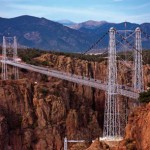Bridge
Waiting in traffic on drawbridges was a fact of life for me as a kid. Unaware of the adult time pressures of schedules and to-do lists, I’d sit in the back of the car watching the stately sailboats gliding like royalty through the raised roadway that halted our progress. Stuck at a standstill, I could get a closer look at the pelicans perched on the watchman’s tower. Once the drawbridge was lowered, I was amazed that we could drive right over a stretch of road that had just a second ago been pointing toward the sky.
Somewhere along the way, that leisurely contentment on bridges gave way to more nervous crossings. I’ve driven over the Golden Gate and Brooklyn Bridges, clomped echoing steps over wooden covered bridges in New England and Madison County, Iowa, hiked across hanging suspension bridges on trails here and there, and cruised over the Mississippi and Ohio Rivers crossing over into neighboring states. There were jaw-dropping views from the Bixby Bridge in Monterey, California, and white-knuckle moments across the Chesapeake Bay Bridge in Maryland. (This bridge is so scary, some people actually pay $50 a day for a service to drive them to work and back!)
Mostly, bridge crossings have been uneventful, but not always. Our car broke down in the middle of the 5-mile long Mackinac Island Bridge in Michigan.
I lost power steering and acceleration and had to coast the last part of the way off the far side. In Colorado, I rode in the back seat hyperventilating as we crossed the Royal Gorge Bridge, the world’s highest suspension bridge, dangling 1,100 feet above the Arkansas River. It was so narrow that passing cars had scant inches between them as they crawled along, and pedestrians walking across had to plaster themselves flat against the railings to avoid being run over. Then there was that one time in a haunted house with my brother where I wet my pants when we crossed a wooden bridge rigged to fall out from under us.
People build bridges, after all–fallible people. Maybe the fact that I hold my breath across them and wince as they sway is more of a flagging trust in human capabilities than an innate fear of bridges themselves. Many of our bridges are aging and need repairs, over 60,000 of them, in fact. So there’s that. The old London-Bridge-is-falling-down nursery rhyme doesn’t really help either. Or those stories about trolls and such living underneath.
Bridges often are the only means to get from here to there, and the truth is, sometimes transitions are just hard. And, oh, goody, life is chock full of these vulnerable, hold-your-breath, learn-to-trust moments. I envy those people who can cartwheel across those bridges with no trepidation. While new and exciting things might wait on the other side, leaving the familiar soil of this side, where my feet are on solid ground and the scenery is just fine, can cause excessive hand wringing.
I have a salt water aquarium in my living room. One night, just after its lights had turned off, I witnessed a hermit crab exchanging its shell for a bigger one. It carefully measured the bigger shell with its antennae. Using its claws to hoist itself up, in one swift move, it hauled itself out of its shell, scuttled across the sand to the new shell, and edged in backwards. Voila! But I was stunned! All we usually see of these crabs is the legs and head, the parts that stick out from under their comfortable shell. When it moved from one shell to the next, its body was revealed. It was a gray comma-like stub, an unformed Voldemort creature. How brave it was to scuttle out from its familiar house, unprotected and exposed!
All of us have our secret underbellies, like the crab, and it’s the worst thing we can think of to crawl out of our comfortable corners and move–grow–into something new. Worse still is to admit to anyone else we might be afraid or unsure of ourselves. Many of us may flinch and wince as we cross bridges of transition—into new careers, empty nests, or life without someone we love. Sometimes, I admit, I cross those bridges trembling on my knees, clinging to the railing and afraid to look down. It helps to have folks around who are no less fearless, but who have made those transitions already. They beckon from the far side, offering encouragement and extending a hand.
Once we make it through our transitions, we can become bridges, of sorts, ourselves. We can span gaps between generations coming along behind and those ahead of us. We can be connectors between old ways of thinking and new. We can extend our hands and assurances that this far side is different, yes, but not so frightening. There are lots of us over here, and we get it.
Twain said that the only person who likes change is a wet baby. Like it or not, change is a constant. Sometimes it demands small alterations, and sometimes it requires of us a full metamorphosis. It’s almost always a surprise and usually terribly inconvenient.
I’m grateful for those who have been on the far sides of my bridges so far. A life that is static and fearful is no life at all. I am learning, slowly, to embrace the change and growth that transitions bring. Sometimes I still squeeze my eyes shut and take hesitant steps, but I have faith that grace will eventually get me where I’m supposed to be. None of us can predict what’s coming down the pike next. But, focusing on the far side, I’ll cross that bridge when I come to it.

